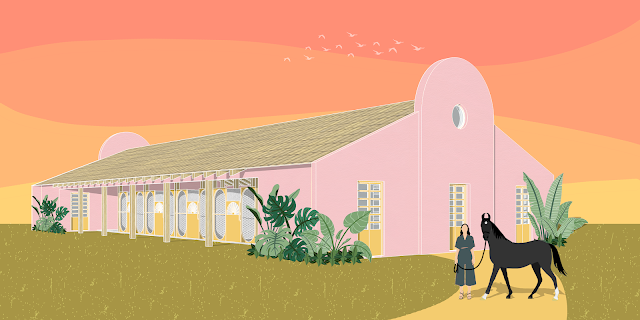After my last pass at designing a barn around eco-centric principles, I decided to take another stab at it in a much simpler way. This time around, I decided to actually use Florida as the hypothetical location. I had a quick zoom call with Dr. Deupi, and we went through some examples from his book that he felt were appropriate.
The most applicable precedent is Caballerizas Sanint in Pereira, Columbia. It was designed by architects Simón Vélez, Felipe Sanint, and Marcelo Villegas. It doesn't take any intuition to see how this project fits into Vélez's portfolio. Villegas is also a huge fan of bamboo and published New Bamboo: Architecture and Design. The main portion of this stable that related back to a Floridian environment is the use of a high, pitched ceiling to allow for adequate airflow. One of the principles of passive cooling is forcing airflow through differences in temperature, having multiple openings, and having a varying size in those openings. In the case of Caballerizas Sanint, the pitch of the roof allows for hot air to move up and away from occupiable spaces while cool air travels straight through the horse stalls. Additionally, this stable utilizes a water trough similar to my last example; it looks like it's just for the horses to drink from, but might create some additional cooling.
The barn also looks sick as fuck at night, so, there's that.
There's nothing complex about my proposal today. Most of the inspiration came from my entrenchment in southern Florida, Art Deco architecture. I love Art Deco. I love bright colors and ornament and putting the sun on everything for no reason. The "valiant attempt" part of this title refers to the fact that I . . . kind of got bored while working on this one. Idk, I was still trying to find the motivation to do anything, so this took way longer than it was supposed to, but I am happy with the finished result.
The crux of this one is to apply a steep roof pitch to keep the hot air moving up while also using the closed short sizes to force air through the space faster. I also wanted to minimize the amount of material used, which is why this is a back-to-back style barn with no additional concrete in front of the stalls. Realistically, you don't need both the Tack Room and the additional Storage Room; the latter is intended to be used for hay, shavings, and equipment while the Tack Room is intended to store tack and grain.
Honestly, unless otherwise stated, it's fair to assume that every tack room I design is intended to be climate-controlled and pest-controlled. I'm of the opinion that if you're operating a barn as a business (or if it's a personal space but just very far away from your house), give yourself an insulated space to keep items that can deteriorate easily in the elements or that may be tempting to rats (i.e. grain). It also creates a comfortable space if you need to be in your barn for an extended period of time, such as when working through business expenses or in an emergency. If you have the money, it's worth it.
The part I had the most fun with was the stall fronts. I wanted the stalls and the doors to have a bit of a cohesive style. Luis Barragán is one of my all time favorite architects. I came across t
his project he did with José Clemente Orozco that had gorgeous clean lines and color pop. These are stall fronts that I would legitimately do for myself in the future if I had a barn that warranted it. I love mesh, and while I don't like half-height or European stall doors for safety reasons, I can get over a 3/4 height.
Overall, this barn ended up a lot more simple than I intended, but it's the first thing I've truly enjoyed working on since graduation. I've even had a couple late nights because I'm that into it. The next design on the table will be a lot more personal and pull from the
Chilean horse stable that I posted a while back. Stay tuned!








Very beautiful!
ReplyDeleteThank you!
Delete